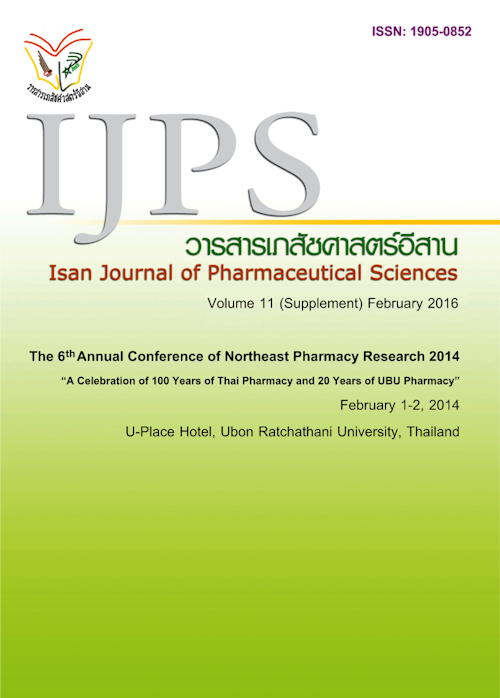Studies on the anti-nociceptive activities of melatonin and its N-benzoyl derivative
Main Article Content
Abstract
Introduction: Melatonin is a hormone secreted by the pineal gland in mammals. It is well documented for antioxidant, anti-inflammatory and anti-nociceptive activities. However, the use of melatonin as an anti-nociceptive agent limited due to its short half-life and low bioavailability. Many efforts have been reported to modify the structure of drugs candidates as esters or amides derivatives to improve physicochemical properties and therapeutic effects. N-benzoyl substitution of melatonin also increase similarity to indomethacin, an anti-inflammatory drug, and might be increase anti-inflammation activity. This study aimed to synthesize N-benzoyl derivative of melatonin and also investigate its anti-nociceptive effects in mice. Materials and Method: N-benzoyl melatonin was synthesized via reacted melatonin with benzoyl chloride and using 4-dimethylaminopyridine as catalyst. The reaction processed under room temperature for 24 hours then purified by column chromatography. Nuclear magnetic resonance (NMR) was use to confirm the structure. The anti-nociceptive activities were carried out using acetic acid induced writhing test and tail flick test to determined dose-dependent respond of melatonin and its N-benzoyl derivatives. Moreover, we also determined time course effect via tail flick test. Results: According from synthesis reaction, we obtained N-benzoyl melatonin as a yellowish crystal with 35% yield. The result of 1H NMR showed five extra proton signals at chemical shift 7.28 to 7.45 ppm. In addition, carbons on the benzene ring show at 132.01, 128.50, 128.15 and 127.74 ppm including with quaternary carbon at chemical shift 173.59 ppm. In tail flick experiment, melatonin at treated doses of 10, 25 and 50 mg/kg significantly increased tail flick latency to 4.7, 5.0 and 5.3 seconds, respectively compare to vehicle treatment (3.0 seconds). With the same doses test, N-benzoyl significantly increased tail flick latency to 4.6, 5.7 and 6.6%, respectively. Moreover, N-benzoyl melatonin also showed longer acting than melatonin in time course study. Effect of melatonin derivative on acetic acid-induced writhing also investigated. N-benzoyl melatonin showed effect for inhibited number of tail flick similar to melatonin (%inhibtion of 10, 25, 50 mg/kg N-benzoyl-melatonin was 34, 7, 38.5, 47.5 %, respectively v.s. %inhibition of melatonin was 28.1, 45.8, 49.0%, respectively) Conclusion: N-benzoyl melatonin, appeared to have higher potency and longer acting for anti-nociceptive than melatonin, suggesting that N-benzoyl-melatonin has potentially to developed as new analgesic drug.
Article Details
In the case that some parts are used by others The author must Confirm that obtaining permission to use some of the original authors. And must attach evidence That the permission has been included


